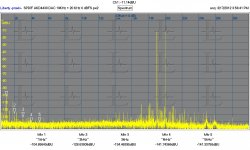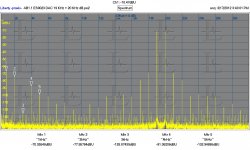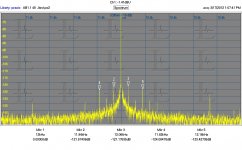Demian, have you actually tried this AKM dac? i had been initially happy when i saw there was an AKM dac option, but after reading the datasheet hmm seems like the sort of dac AKM deems fit for ipod duties max performance of -91db THD seems pretty average for a 24bit/192khz dac and as it has internal absolutely everything, there isnt much to play with, internal buffer, internal charge pump and seems tuned for systems with excessive clock jitter? not something we have to worry about a great deal.
yep, well not quite; the AK4396 has an internal 24bit 8 x OS filter, -100dB THD+N and 120db DNR, but AK4390 and AK4399 are 32bit dacs (actually this seems the new flagship, has internal 32bit, or optional external digital filter ) I havent read the datasheet in detail or even far enough to see if its a multibit dac like the 4396. but it scrapes 5dB THD and 3dB DNR performance better as well vs -100 and 120dB for 4396, with AK4390 on -103dB THD+N and 120db DNR, which also has 32bit internal OS filter.
It's still not even close to sabres numbers, but still very interesting chips, particularly the option for external filter and AKM make some pretty nice ones. ive had good experience with the AKM gear too in RME studio gear. apparently the Schitt bifrost uses the AK4399 (still cant get past that company name)
anyway its all academic now, i just wondered
It's still not even close to sabres numbers, but still very interesting chips, particularly the option for external filter and AKM make some pretty nice ones. ive had good experience with the AKM gear too in RME studio gear. apparently the Schitt bifrost uses the AK4399 (still cant get past that company name)
anyway its all academic now, i just wondered
Last edited:
Would I have suggested it without listening? Remember this is not the last word in DAC's and you can still invest hours into making the DAC chip of your dreams work. Of course I have listened to the eval board. I have also measured it. I can't say its on par with a $50 ESS9018 but its very good. I found it preferable to a Proton in my listening, and this is via SPDIF and a $3 wall wart unregulated primary supply to run the eval board.
I have also measured it at length as well as the AB1.1. There is too much data to wade through here so I will highlight it.
The AK4430 has 2nd harmonc distortion but very little above the second. At -6 dBFS the 2nd is -90 and everything else is -110. The ESS9023 same conditions in the AB1.1 is -60 for the 2nd with 3,4,5 etc. at -65 to -67.
But these two pictures should show the real strength of the AK4430:
I have also measured it at length as well as the AB1.1. There is too much data to wade through here so I will highlight it.
The AK4430 has 2nd harmonc distortion but very little above the second. At -6 dBFS the 2nd is -90 and everything else is -110. The ESS9023 same conditions in the AB1.1 is -60 for the 2nd with 3,4,5 etc. at -65 to -67.
But these two pictures should show the real strength of the AK4430:
Attachments
Demian, could you check the logo of your 22MHz oscillator? On some AB-1.1s I had to use a different brand. I now have a new pile of Golledge 22MHz XOs.
At Golledge, the 24MHz XO is a standard product while the 22MHz XO is a custom part with the same spec.
Børge
I may have spoke too soon. I have upgraded my test capability with the addition of an AKD5394 eval board. Adding a high performance external oscillator I now have a really low noise floor (-160 dB+) and good extra low distortion capture. I remeasured the AB1.1 with a 44.1KHz and a 48KHz JTest. The 44.1 has a few more spurs but the peaks are pretty similar. These plots are formatted as close as I can to the Stereophile format. Figure that -120 dB is approx 20 pS (I think).
Attachments
ahh sorry i figured you would know it, probably you have seen it. it will require very high quality layout and its not cheap, but would be tweakable for frequency output, in fact multiple frequency output should not be too difficult provided it can be gotten up to useful speed and you will know that better than I
Linear Tech Application Note 67. from Dale Eagar a composite opamp Wein Bridge type oscillator. i have all the opamps it needs funnily enough
Nice oscillator for low distortion audio, but it won't work at 22MHz.
yeah i thought that might be a possible issue, so maybe just good for testing distortion. re the dac, yeah i suppose, i wasnt thinking of the comparison to the 9023, ive never been a huge fan of that chip. distortion profile of the AKM sounds good, but i think i'll probably just stick to the 9012, if it was a higher end AKM with fun to be had with filters etc i would be more interested.
I think the AK4430 is a reasonable upgrade for the AB1. Its very easy to implement and will pretty much just work. The more exotic DAC's all require analog sections etc. Those require power supplies not present on the existing design. And usually they will be connected to an external system bringing up the issues of isolation etc. Each of these issues is quite the undertaking. Alex, Borge, et. al. have done an enormous amount of work to get it this far. The I2S interface using a RJ45 would be a realistic starting point for more complex projects. I'll be using it a lot for testing dacs. I wish I had that board now.
hey i'm not whining, just saying i probably wont use the AKM like i thought. agreed it makes a simple chip to implement and get decent sound, the problem is IMO such chips make it difficult to make excellent sound as its all integrated and it leaves less to play around with. i was not expecting crazy good anyway as like you say best to use the i2s out. i'm covered for highly tuned dacs already, i'm looking for fun and experimentation.
Hello,
I landed by chance on this thread as I was going to start searching for a USB-based audio recorder. Does anyone know if this exists? What I mean is I want the equivalent of a little zoom H2 recorder (or Tascam porta studio type thing) but that records wav files only. Without a computer. A friend suggested I could probably do this with an Arduino.
any ideas?
This isn't exactly my area of expertise...
Thank you
I landed by chance on this thread as I was going to start searching for a USB-based audio recorder. Does anyone know if this exists? What I mean is I want the equivalent of a little zoom H2 recorder (or Tascam porta studio type thing) but that records wav files only. Without a computer. A friend suggested I could probably do this with an Arduino.
any ideas?
This isn't exactly my area of expertise...
Thank you
Hello,
I landed by chance on this thread as I was going to start searching for a USB-based audio recorder. Does anyone know if this exists? What I mean is I want the equivalent of a little zoom H2 recorder (or Tascam porta studio type thing) but that records wav files only. Without a computer. A friend suggested I could probably do this with an Arduino.
any ideas?
This isn't exactly my area of expertise...
Thank you
Whats wrong with the H2?
mmmh... I guess we'll want to have a look at this:
http://www.diyaudio.com/forums/digi...-i2s-m2tech-vs-xmos-vs-open-source-qnktc.html
http://www.diyaudio.com/forums/digi...-i2s-m2tech-vs-xmos-vs-open-source-qnktc.html
J3 and J4 are for bypassing the ADP151s. Or for tapping their output to whatever you choose to patch onto the board. Remove R22, R23, respectively, for bypass.
Please verify this for the uninitiated like me... For an external 3.3v/5v ps I do the following;
J5 - 1 : no connection
J5 - 2: +5v from external ps
J5 - 3: +3.3v from external ps
J5 - 4: ground from external ps
Remove R22/R23
Recommended by others: no cap on C15 if using external ps.
Thanks for the handholding...
Borges,
is it necessary to have Vbus connected to the incoming 5V supply from the USB connector for the AB1.1 to handshake with the computer?
At the moment I have removed the 0Ohm link to J5 and supply J5 from a battery. But I understand that the digital board is still running from Vbus. More importantly its ground, shared with the analog board, is connected to the PC ground. In order to isolate the AB1.1 from PC ground, I was thinking of severing the incoming 5V and ground connections from the USB connector and connecting the now isolated VBUS to the J5 supply.
Would this work? I have read that a number of USB dac do not work if the USB supply is severed.
TIA
Giulio
is it necessary to have Vbus connected to the incoming 5V supply from the USB connector for the AB1.1 to handshake with the computer?
At the moment I have removed the 0Ohm link to J5 and supply J5 from a battery. But I understand that the digital board is still running from Vbus. More importantly its ground, shared with the analog board, is connected to the PC ground. In order to isolate the AB1.1 from PC ground, I was thinking of severing the incoming 5V and ground connections from the USB connector and connecting the now isolated VBUS to the J5 supply.
Would this work? I have read that a number of USB dac do not work if the USB supply is severed.
TIA
Giulio
Last edited:
Hi guys,
manufacturing of the AB-1.12 and AB-1.13 prototype boards is progressing. I'll mail all of you when the I have inspected the boards.
In the meantime, chill out with the documentation files. Here you'll find schematics, BOM etc.
If you plan to populate the ES9012/18, make very sure that you understand the copper structures below the IC. They are in the *_pcb.pdf files. There are some test points which must be strapped together underneath the chip in order to give it the right hardware configuration. I'm no expert on the ES9012/18, so don't ask me about the finer points of the strapping.
Files are here:
http://code.google.com/p/sdr-widget/downloads/detail?name=Ab-1.12.13_20120315_C_doc.zip
Cheers,
Børge
manufacturing of the AB-1.12 and AB-1.13 prototype boards is progressing. I'll mail all of you when the I have inspected the boards.
In the meantime, chill out with the documentation files. Here you'll find schematics, BOM etc.
If you plan to populate the ES9012/18, make very sure that you understand the copper structures below the IC. They are in the *_pcb.pdf files. There are some test points which must be strapped together underneath the chip in order to give it the right hardware configuration. I'm no expert on the ES9012/18, so don't ask me about the finer points of the strapping.
Files are here:
http://code.google.com/p/sdr-widget/downloads/detail?name=Ab-1.12.13_20120315_C_doc.zip
Cheers,
Børge
Borges,
is it necessary to have Vbus connected to the incoming 5V supply from the USB connector for the AB1.1 to handshake with the computer?
TIA
Giulio
Vbus is a sense pin fir the uC and had to havr +5V for USB enumeration. It has to be referenced to uC ground. D+/D- are differential but they have to be referenced to USB ground.
So what you propose to do looks likr it will not work.
Options fir USB isolation arr
1. isolated USB hub - makr surr it is USB high speed.
2. Opto isolation of i2s and MCLK.
Alex
Options fir USB isolation arr
set phone_key_size = small;
set pirate_mode = true;
(sorry. just a little fun)
set phone_key_size = small;
set pirate_mode = true;
(sorry. just a little fun)
Hm
- Home
- Source & Line
- Digital Source
- Open-source USB interface: Audio Widget



